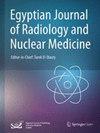Efficiency assessment of a two-stage diagnostic strategy combining CT angiography and fractional flow reserve derived from coronary CT angiography for the detection of myocardial ischemia: a simulation study
IF 0.5
Q4 RADIOLOGY, NUCLEAR MEDICINE & MEDICAL IMAGING
Egyptian Journal of Radiology and Nuclear Medicine
Pub Date : 2024-06-17
DOI:10.1186/s43055-024-01281-4
引用次数: 0
Abstract
The importance of a diagnostic strategy combining coronary computed tomography angiography (CCTA) with fractional flow reserve derived from CCTA (FFRCT) for detecting myocardial ischemia is increasing. However, sensitivity and specificity alone may be insufficient to understand the efficiency characteristics of a diagnostic strategy combining CCTA and FFRCT (DSCCF). Our study aimed to evaluate the overall efficiency of DSCCF in detecting myocardial ischemia and compare it with other diagnostic strategies to determine whether evaluation by DSCCF is currently appropriate. This simulation study included 1000 patients with stable chest pain and suspected myocardial ischemia. Using a decision tree analysis, assuming a diagnostic strategy of adding FFRCT to CCTA-positive patients, we calculated the following efficiency parameters of DSCCF: (1) true positive (TP), false positive (FP), net false negative (FN), and net true negative (TN) test results; (2) net sensitivity; (3) net specificity; (4) positive predictive value; (5) negative predictive value; (6) post-test probability; (7) diagnostic accuracy; (8) diagnostic odds ratio; and (9) number needed to diagnose. We also calculated the efficiency parameters of other diagnostic strategies and compared them with those of DSCCF. In the basic setting, regarding efficiency parameters (1), the number of TPs, FPs, net FNs, and net TNs were 254, 69, 46, and 631, respectively. Efficiency parameters (2)–(9) were 0.85 (95% confidence interval [CI], 0.80–0.89), 0.90 (95% CI 0.88–0.92), 0.79 (95% CI 0.74–0.83), 0.93 (95% CI 0.91–0.95), 0.07 (95% CI 0.05–0.09), 0.89 (95% CI 0.86–0.90), 50.50 (95% CI 33.83–75.37), and 1.34 (95% CI 1.24–1.48), respectively. Compared with other diagnostic strategies, DSCCF had good efficiency parameters. Moreover, the sensitivity analysis did not reveal any evidence to contradict the findings in the basic setting. This study demonstrated the diagnostic ability characteristics of DSCCF by assessing various efficiency parameters. Compared with other diagnostic strategies, DSCCF had good efficiency. In terms of efficiency, evaluation using DSCCF for detecting myocardial ischemia appears to be appropriate.结合 CT 血管造影和冠状动脉 CT 血管造影得出的分数血流储备检测心肌缺血的两阶段诊断策略的效率评估:一项模拟研究
结合冠状动脉计算机断层扫描血管造影(CCTA)和由 CCTA 导出的分数血流储备(FFRCT)的诊断策略在检测心肌缺血方面的重要性与日俱增。然而,仅凭敏感性和特异性可能不足以了解结合 CCTA 和 FFRCT(DSCCF)的诊断策略的效率特征。我们的研究旨在评估 DSCCF 在检测心肌缺血方面的整体效率,并将其与其他诊断策略进行比较,以确定 DSCCF 评估目前是否合适。这项模拟研究包括 1000 名患有稳定型胸痛并疑似心肌缺血的患者。通过决策树分析,假设诊断策略是在 CCTA 阳性患者中增加 FFRCT,我们计算了 DSCCF 的以下效率参数:(1) 真阳性 (TP)、假阳性 (FP)、净假阴性 (FN) 和净真阴性 (TN) 检测结果;(2) 净灵敏度;(3) 净特异性;(4) 阳性预测值;(5) 阴性预测值;(6) 检测后概率;(7) 诊断准确性;(8) 诊断几率;(9) 诊断所需人数。我们还计算了其他诊断策略的效率参数,并与 DSCCF 的效率参数进行了比较。在基本设置中,关于效率参数(1),TPs、FPs、净 FNs 和净 TNs 的数量分别为 254、69、46 和 631。效率参数(2)-(9)分别为 0.85(95% 置信区间 [CI],0.80-0.89)、0.90(95% CI 0.88-0.92)、0.79(95% CI 0.74-0.83)、0.93(95% CI 0.91-0.95)、0.07(95% CI 0.05-0.09)、0.89(95% CI 0.86-0.90)、50.50(95% CI 33.83-75.37)和 1.34(95% CI 1.24-1.48)。与其他诊断策略相比,DSCCF具有良好的效率参数。此外,敏感性分析也没有发现任何与基本设置中的结果相矛盾的证据。本研究通过评估各种效率参数,展示了 DSCCF 的诊断能力特征。与其他诊断策略相比,DSCCF 具有良好的效率。就效率而言,使用 DSCCF 检测心肌缺血的评估似乎是合适的。
本文章由计算机程序翻译,如有差异,请以英文原文为准。
求助全文
约1分钟内获得全文
求助全文
来源期刊

Egyptian Journal of Radiology and Nuclear Medicine
Medicine-Radiology, Nuclear Medicine and Imaging
CiteScore
1.70
自引率
10.00%
发文量
233
审稿时长
27 weeks
 求助内容:
求助内容: 应助结果提醒方式:
应助结果提醒方式:


